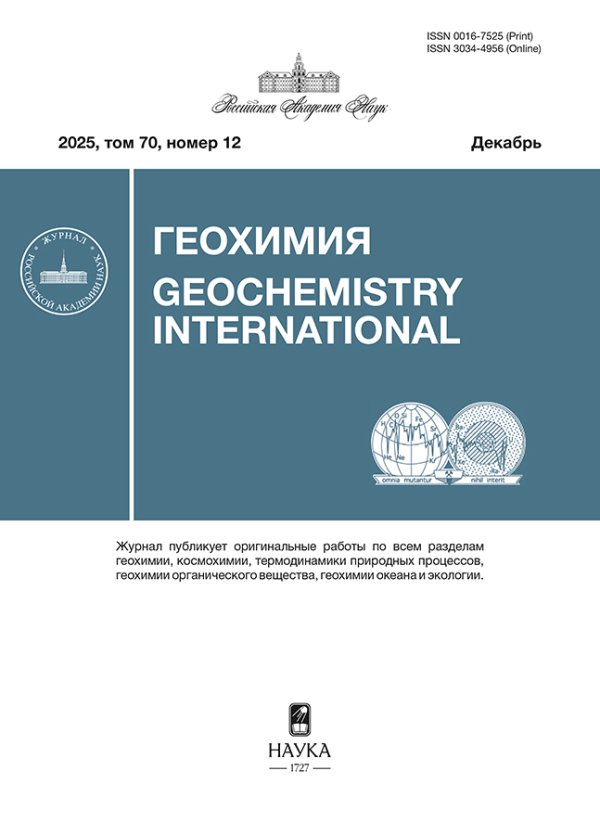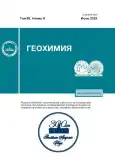Дифференцированная оценка содержания 137Cs на биогенном и литогенном взвешенном веществе в Черном море
- Авторы: Сидоров И.Г.1, Мирошниченко О.Н.1, Проскурнин В.Ю.1, Параскив А.А.1
-
Учреждения:
- Федеральное государственное бюджетное учреждение науки Федеральный исследовательский центр “Институт биологии южных морей имени А.О. Ковалевского РАН”
- Выпуск: Том 68, № 6 (2023)
- Страницы: 629-637
- Раздел: Статьи
- URL: https://journals.rcsi.science/0016-7525/article/view/134817
- DOI: https://doi.org/10.31857/S001675252304012X
- EDN: https://elibrary.ru/JXCYCM
- ID: 134817
Цитировать
Полный текст
Аннотация
Седиментационный транспорт 137Cs может приводить к накоплению этого радионуклида на глубинах, куда он не мог бы попасть в заметных количествах только за счёт вертикального водообмена, поэтому сравнительная оценка его содержания для различных типов взвеси и регионов Черного моря представляет особый интерес. В связи с этим, был осуществлен отбор проб взвешенного вещества (ВВ) и морской воды на глубоководных и прибрежных станциях для последующего определения содержания 137Cs в поверхностном слое воды. Для расчета доли литогенного вещества дополнительно определяли содержание калия во взвеси. Диапазон содержания 137Cs на ВВ для различных станций отличался более чем на порядок – для удельной активности от 7 до 111 Бк/кг, для содержания на взвеси в %, от общего содержания в поверхностном слое воды от 0.03 до 0.69%. Более удаленные от берега станции характеризовались наименьшим процентным содержанием 137Cs на ВВ, тогда как на прибрежных эта величина была более вариабельной. Сопоставление вклада литогенного и биогенного вещества во взвеси и данных по 137Cs для различных станций говорит о том, что содержание этого радионуклида во ВВ определяется в первую очередь динамикой изменения содержания литогенной фракции. В отношении миграции 137Cs на ВВ это приводит к наличию в Черном море как минимум двух регионов. Во-первых, это акватории, достаточно удаленные от источников литогенного вещества и в которых ВВ образуется в основном за счет деятельности живых организмов. Содержание 137Cs на взвеси благодаря преобладанию биогенного вещества и незначительной концентрации литогенного в данном случае находится на уровне сотых долей процента от его общего содержания в поверхностном слое воды. Во-вторых, это прибрежные и шельфовые акватории, подверженные с одной стороны береговому и речному стоку значительных количеств литогенного вещества, с другой – характеризуемые повышенной трофностью и биологической продуктивностью. В этих акваториях благодаря изменчивости биотических и абиотических факторов содержание 137Cs на ВВ более вариабельно и может испытывать колебания от значений, характерных для открытого моря, до на порядок больших.
Ключевые слова
Об авторах
И. Г. Сидоров
Федеральное государственное бюджетное учреждение науки Федеральный исследовательский центр “Институт биологии южных морей имени А.О. Ковалевского РАН”
Email: oksaniya_89@mail.ru
Россия, 299011, Севастополь, проспект Нахимова, д. 2,
О. Н. Мирошниченко
Федеральное государственное бюджетное учреждение науки Федеральный исследовательский центр “Институт биологии южных морей имени А.О. Ковалевского РАН”
Email: oksaniya_89@mail.ru
Россия, 299011, Севастополь, проспект Нахимова, д. 2,
В. Ю. Проскурнин
Федеральное государственное бюджетное учреждение науки Федеральный исследовательский центр “Институт биологии южных морей имени А.О. Ковалевского РАН”
Email: oksaniya_89@mail.ru
Россия, 299011, Севастополь, проспект Нахимова, д. 2,
А. А. Параскив
Федеральное государственное бюджетное учреждение науки Федеральный исследовательский центр “Институт биологии южных морей имени А.О. Ковалевского РАН”
Автор, ответственный за переписку.
Email: oksaniya_89@mail.ru
Россия, 299011, Севастополь, проспект Нахимова, д. 2,
Список литературы
- Виноградов А.П. (1962) Средние содержания химических элементов в главных типах изверженных горных пород земной коры. Геохимия. (7), 555-571.
- Гавшин В.М., Лапухов С.В., Сараев С.В. (1988) Геохимия литогенеза в условиях сероводородного заражения (Черное море). Новосибирск: Наука, 194 с.
- Гулин С.Б., Егоров В.Н, Мирзоева Н.Ю., Проскурнин В.Ю., Бей О.Н., Сидоров И.Г. (2017) Радиоемкость кислородной и сероводородной зон Черного моря в отношении 90Sr и 137Cs. Радиационная биология. Радиоэкология. 57(2), 191-200.
- Гулин С.Б., Сидоров И.Г., Поповичев В.Н. (2019) Сезонная динамика биоседиментации и первичной продукции в Севастопольской бухте: оценка взаимосвязи с использованием 234Th и 40K. Биология моря. 45, 171-176.
- Дунаева А.Н., Мироненко М.В. (2000) Сорбция цезия некоторыми глинистыми минералами. Геохимия. (2), 213-221
- Егоров В.Н., Гулин С.Б., Поповичев В.Н., Костова С.К., Гулина Л.В., Малахова Л.В., Малахова Т.В., Плотицына О.В., Мирзоева Н.Ю., Терещенко Н.Н., Лазоренко Г.Е., Проскурнин В.Ю., Сидоров И.Г., Стецюк А.П., Марченко Ю.Г. (2013) Биогеохимические механизмы формирования критических зон в отношении загрязняющих веществ в Черном море. Морской экологический журнал. 12(4), 5-26.
- Егоров В.Н., Поликарпов Г.Г., Кулебакина Л.Г., Стокозов Н.А., Евтушенко Д.Б. (1993) Модель крупномасштабного загрязнения Черного моря долгоживущими радионуклидами цезием–137 и стронцием–90 в результате аварии на ЧАЭС. Водные ресурсы. 20(3), 326-330.
- Иванов В.В. (1994) Книга 1: s-элементы. Экологическая геохимия элементов: Справочник: в 6 кн. (Под ред. Э. К. Буренкова). М.: Недра, 304 с.
- Касаткина, Н.Е., (2008) Адсорбция радионуклидов цезия на донных отложениях и оценка радиоэкологической ситуации в бассейнах Баренцева и Азовского морей (дис. канд. хим. наук: 03.00.16). Иваново.
- Козловский Е.А. (1991) Горная энциклопедия. Т. 1–5. М.: Советская энциклопедия, 541 с.
- Матишов Д.Г. (2001) Радиационная экологическая океанология. Апатиты: Изд-во КНЦ РАН, 417 с.
- Митропольский А.Ю., Безбородов А.А., Овсяный Е.И. (1982) Геохимия Черного моря. К.: Наукова думка, 144 с.
- Никитин А.И., Мединец В.И., Чумичев В.Б., Катрич И.Ю., Вакуловский С.М., Козлов А.И., Лепешкин В.И. (1988) Радиоактивное загрязнение Черного моря вследствие аварии на ЧАЭС по состоянию на октябрь 1986 г. Атомная энергия. 65(2), 134-137.
- Перельман А.И. (1972) Геохимия элементов в зоне гипергенеза. М.: Недра, 424 с.
- Cнегирева О.В. (1969) Юрская система, Средний отдел. Геология СССР. Т. 8. Крым. Часть 1. Геологическое описание (Под ред. М.В. Муратова). М.: Недра, 99-114.
- Стокозов Н.А., Гулин С.Б., Мирзоева Н.Ю. (2008) Содержание 137Cs и 90Sr на взвешенном веществе и в донных отложениях Черного моря после аварии на Чернобыльской АЭС. Радиоэкологический отклик Черного моря на чернобыльскую аварию (Под ред. Г.Г. Поликарпова и В.Н. Егорова). Севастополь: ЭКОСИ-Гидрофизика, 519-547.
- Aston S.R., Duursma E.K. (1973) Concentration effects on 137Cs, 65Zn, 60Co and 106Ru sorption by marine sediments with geochemical implications. Netherlands J. Sea Research. 6(1–2), 225-240.
- Brumsack H.-J. (2006) The trace metal content of recent organic carbon-rich sediments: implications for Cretaceous black shale formation. Palaeogeogr. Palaeoclimatol. Palaeoecol. 232(2–4), 344-361
- Buesseler K.O., Livingston H.D., Honjo S., Hay B.J., Konuk T., Kempe S. (1990) Scavenging and particle deposition in the southern Black Sea – evidence from Chernobyl radiotracers. Deep–Sea Res. 37(3), 413-430.
- Comans R.N., Haller M., Preter P.D. (1991) Sorption of cesium on illite: Nonequilibrium behavior and reversibility. Geochim. Cosmochim. Acta. 55(2), 433-440.
- Cremers A., Elsen A., Preter P.De, Maes A. (1988) Quantitative analysis of radiocaesium retention in soils. Nature. 335(6187), 247-336.
- Dumat C. (1999) Reduced adsorption of caesium on clay minerals caused by various humic substances. J. Environ. Radioact. 46, 187-195
- Durrant C.B., Begg J.D., Kersting A.B., Zavarin M. (2018) Cesium sorption reversibility and kinetics on illite, montmorillonite, and kaolinite. Sci. Total Environ. 610, 511-520.
- Duursma E.K. (1996) Environmental compartments: equilibria and assessment of processes between air, water, sediments and biota. E.K. Duursma, J. Carroll. Berlin: Springer, 280 p.
- Fuller A.J., Shaw S., Ward M.B., Haigh S.J., Mosselmans J.F.W., Peacock C.L., Stackhouse, S., Dent A.J., Trivedi D., Burke I.T. (2015) Caesium incorporation and retention in illite interlayers. Appl. Clay Sci. 108, 128-134.
- Gulin S.B., Egorov V.N., Duka M.S., Sidorov I.G., Proskurnin V.Yu., Mirzoyeva N.Yu., Bey O.N., Gulina L.V. (2015) Deep-water profiling of 137Cs and 90Sr in the Black Sea. A further insight into dynamics of the post-Chernobyl radioactive contamination. J. Radioanal. Nucl. Ch. 304(2), 779-783.
- Gulin S.B., Mirzoyeva N.Yu., Egoron V.N., Polikarpov G.G., Sidorov I.G., Proskurnin V.Yu. (2013) Secondary radioactive contamination of the Black Sea after Chernobyl accident: recent levels, pathways and trends. J. Environ. Radioact. 124, 50-56.
- Gulin S.B., Gulina L.V., Sidorov I.G., Proskurnin V.Yu., Duka M.S., Moseichenko I.N., Rodina E.A. (2014) 40K in the Black Sea: a proxy to estimate biogenic sedimentation. J. Environ. Radioact. 134, 21-26.
- Gulin S.B., Polikarpov G.G., Egorov V.N., Korotkov A.A., Stokozov N.A., Martin J.M. (2001) Radioactive contamination of the north-western Black Sea sediments. Estuar. Coast. Shelf Sci. 54(3), 541-549.
- Hay B.J., Arthur M.A., Dean W.E., Neff E.D., Honjo S. (1991) Sediment deposition in the Late Holocene abyssal Black Sea with climatic and chronological implications. Deep Sea Research Part A. Oceanographic Research Papers. 38(suppl. 2), 1211-1236.
- International Atomic Energy Agency (1985) Sediment KdS and Concentration Factors for Radionuclides in the Marine Environment. Technical Report Series. (247). IAEA, 74 p.
- Kim Y., Cho S., Kang H.-D., Kim W., Lee H.-R., Doh S.-H., Kim K., Yun S.-G., Kim D.-S., Jeong G.Y. (2006) Radiocesium reaction with illite and organic matter in marine sediment. Mar. Pollut. Bull. 52(6), 659-665.
- Lammers L.N., Bourg I.C., Okumura M., Kolluri K., Sposito G., Machida M. (2017) Molecular dynamics simulations of cesium adsorption on illite nanoparticles. J. Colloid and Interface Science. 490, 608-620.
- Livingston H.D. (1988) The use of Cs and Sr izotopes as tracers in the Arctic Mediterranean Seas. Philosophical Transactions of the Royal Society of London. Series A, Mathematical and Physical Sciences. 325(1583), 161-176.
- Lujanienė G., Vilimaitė-Šilobritienė B., Jokšas K. (2003) Effect of coatings on caesium sorption-desorption behavior in bottom sediments. Environmental and Chemical Physics. 25(3), 129-135.
- Martinez N.C., Murray R.W., Thunell R.C., Peterson L.C., Muller-Karger F., Astor Y., Varela R. (2007) Modern climate forcing of terrigenous deposition in the tropics (Cariaco Basin, Venezuela). Earth Planet. Sci. Lett. 264(3–4), 438-451.
- Miroshnichenko O.N., Paraskiv A.A., Gulin S.B. (2019) Cesium-137 Concentration in the Surface Waters of Eurasian Seas: Evidence from the Expedition Research of 2017. Geochem. Int. 57(12), 1349-1354.
- Polikarpov G.G., Kulebakina L.G., Timoshchuk V.I., Stokozov N.A. (1991) 90Sr and 137Cs in surface waters of the Dnepr River, the Black Sea and the Aegean Sea in 1987 and 1988. J. Environ. Radioact. 13(1), 25-28.
- Sawhney B.L. (1972) Selective sorption and fixation of cations by clay minerals: A review. Clays and Clay Minerals. 20(2), 93-100.
- Sidorov I.G., Tereshchenko N.N., Korotkov A.A., Chuzhikova-Proskurnina O.D., Hiep N.T., Trapeznikov A.V. (2022) 137Cs, 40K and 210Po in abiotic components of aquatic ecosystems two rivers in the Can Gio biosphere reserve, Vietnam. Nuclear Engineering and Technology. (Available online 6 July 2022) https://doi.org/10.1016/j.net.2022.07.005
- Turekian K.K., Wedepohl K.H. (1961) Distribution of the elements in some major units of the Earth’s crust. Geol. Soc. Am. Bull. 72(2), 175-192.
Дополнительные файлы














